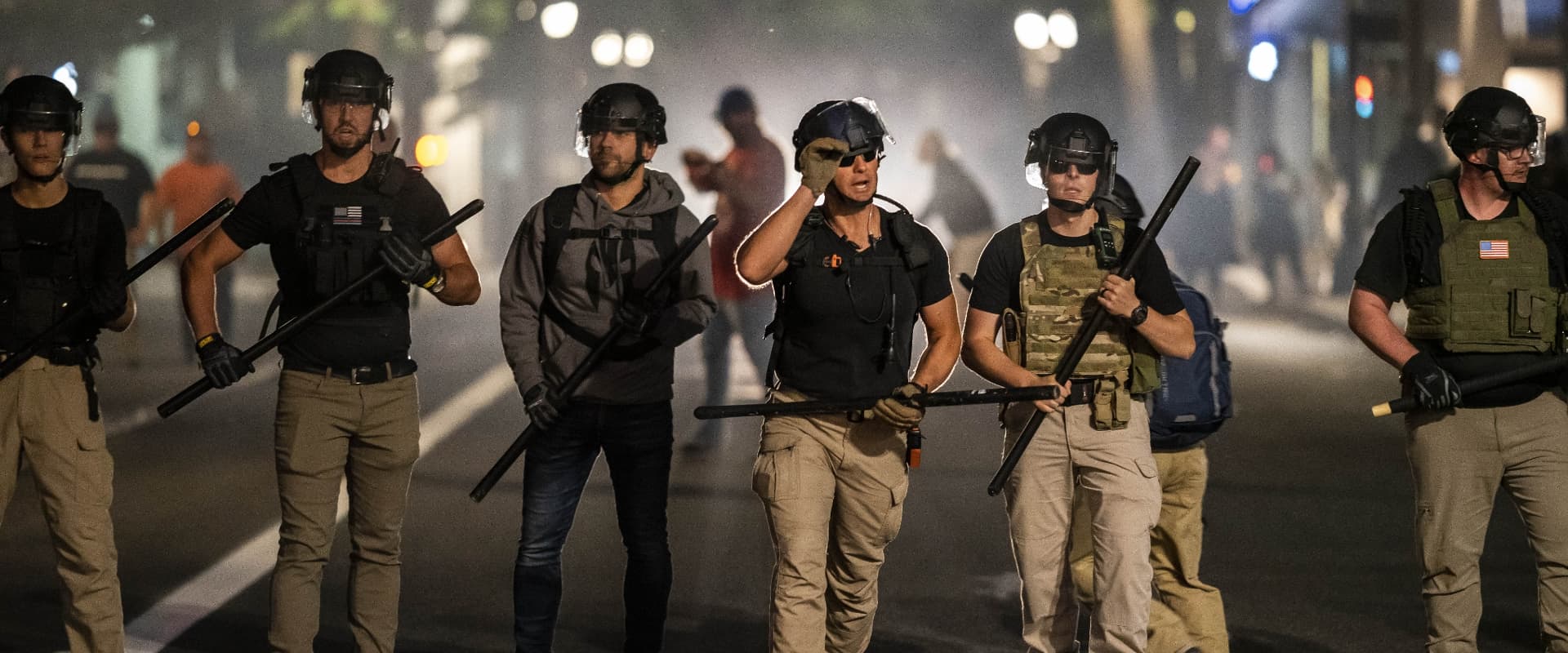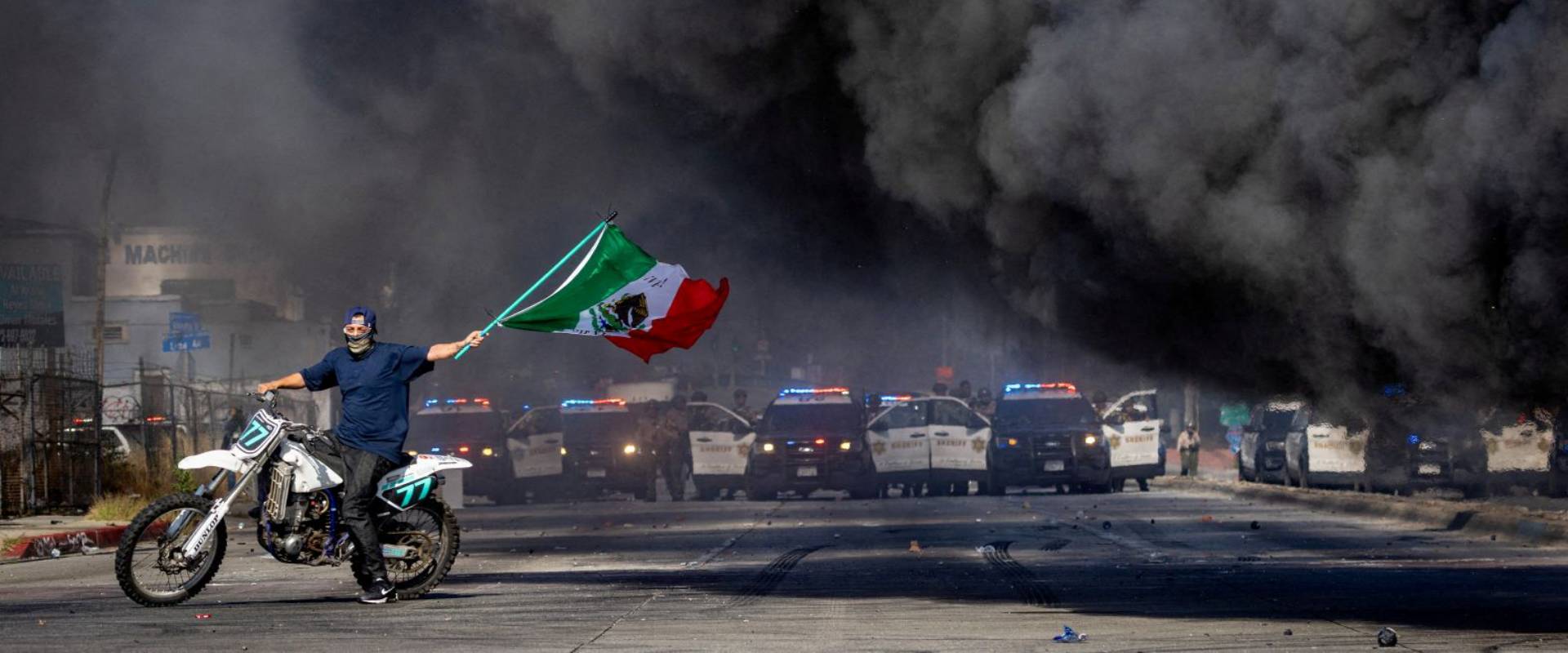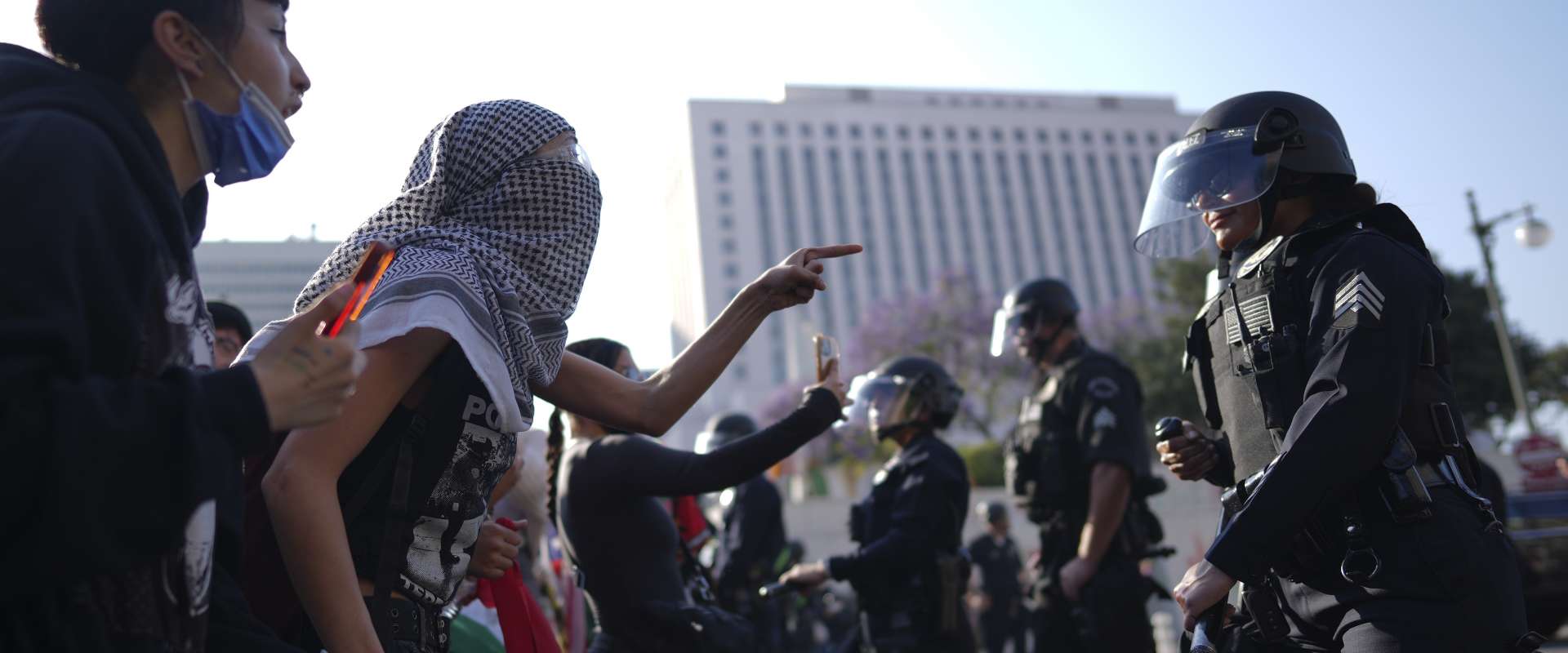In Indianapolis on Labor Day last September, a group of about thirty neo-Nazis from an organization called Patriot Front marched downtown. Cosplaying in their faux military garb and carrying shields and colonial-themed US flags, this crew of sad grotesques was easily outnumbered by the hundreds of workers — moms, dads, kids, and other everyday people — rallying nearby in support of labor unions. In response, Destiny Wells, the Democratic candidate for the secretary of state tweeted: “This is literally fascism versus democracy. The choice isn’t hard. #VoteBlueIn2022.”
Wells is correct to label the marchers fascists. From anti-vaccination conspiracy theories to attacks on and demonization of queer people and immigrants to renewed glorifications of racial violence, the far right has been mobilizing across the United States and internationally for the better part of the past decade. These attacks take different forms: as policies passed by increasingly far-right-influenced governments; and, particularly in the US, as street violence and mass murder, especially against Black and Brown people, immigrants, and queer-identifying people.
Without minimizing any of these developments, it must be asked: is fascism really around the corner? Is “voting blue” the correct strategy to prevent this? And if we’re not yet at full-blown fascism, what analysis do we need and how do we act to prevent such a fascist future?
While a small example, Wells’s tweet reflects a much more widely held belief that the most effective way to confront the far right, whether in government or outside it, is by “voting harder,” invoking democracy, and putting our faith in the institutions of the liberal state. The history of the rise of fascism and the failures and successes of antifascist movements, however, highlights exactly the opposite lesson: the passivity of putting faith in the liberal state widens the openings for fascism to take power. By contrast, it is the self-activity of the working class and oppressed, politically and physically confronting fascists, that defeats them.
In particular, the history of the socialist and communist movement over the past century holds lessons for antifascists today who are attempting to wade through the morass of liberalism, its passivity and its erasure of the material conditions for the re-emergence of fascism. To both analyze these material conditions and to develop an effective strategy, we need to draw on and update the lessons of revolutionary socialism.
The European interwar context: reformism, ultra-leftism, and the popular front
To better understand the revolutionary socialist approach to fascism, it is important to contextualize it historically. During the years between World War I and II, European socialism responded to the rise of fascism with three strategies distinct from that of revolutionary socialism: reformism, ultra-leftism, and popular frontism.
The conduct of the German Social Democratic Party (SPD), and of the Second International more generally, can be characterized as reformist. The SPD’s and its sibling parties’ votes in support of their bourgeoisies in the lead up to the First World War were already a tremendous betrayal of the international working-class movement. Their response to fascism was just as calamitous. As Mike Taber and John Riddell write in their helpful introduction to Clara Zetkin’s Fighting Fascism: How to Struggle and How to Win, reformists argued that fascism was “nothing but terror and violence” and saw it as a direct extension — the “cat’s paw”— of bourgeois rule. Implicit in this perspective was the reformists’ pessimism about the working class’s ability to shake the ruling class’s position. Thus, the proletariat was not up to the task of confronting the fascists and must not provoke them. As Taber and Riddell point out, this was saying, basically, that with respect to the fascists, you should “ignore them and they’ll go away.” This went along with asking the proletariat to put their faith in the institutions of liberal democracy, echoing those today who want us to “vote blue.”
The history of the socialist and communist movement over the past century holds lessons for antifascists today who are attempting to wade through the morass of liberalism, its passivity and its erasure of the material conditions for the re-emergence of fascism. To both analyze those material conditions and to develop an effective strategy, we need to draw on and update the lessons of revolutionary socialism.
By contrast, the first response by the new, revolutionary Communist International, swung to the ultra-left. In response to the fascist takeover in Italy in 1922, Comintern delegates Grigori Zinoviev and Amadeo Bordiga theorized that fascism was, basically, bourgeois terror and an extreme form of anti-communism. Comintern comrades such as Clara Zetkin, who would soon develop a much more sophisticated and correct theorization, rightly pointed out that Zinoviev and Bordiga focused only on the militaristic aspect of fascism (about which, more below). For this reason, ultra-leftists did not feel compelled to analyze the phenomenon from the political, economic, or ideological perspectives. They drew the conclusion that there was no qualitative difference between different forms of bourgeois rule and saw the moderate bourgeois and even reformist labor leaders as collaborators of fascists.
Once he took over the Comintern in the late 1920s, Stalin would, disastrously, remain faithful to the ultra-left theory, with Stalinized parties averring that the reformist socialists were nothing more than “social fascists.” This led the German Communist Party (KPD), by then Stalinized, to fatally underestimate the rise of the Nazis (even in 1933, their leaders argued that “after Hitler it will be our turn”). Further, the sectarianism of Stalinism’s position at this juncture blighted any attempts — and there were many — at uniting the two German mass socialist parties to fight Nazism.
By the mid-1930s, in a bid to conciliate liberal capitalist states in response to the rise of Hitler, Stalin zig-zagged rightward and developed the strategy of the popular front. Popular frontism distinguished “extreme reactionary layers of bourgeoisie” from supposedly more democratic, moderate layers. Communists, argued Stalinist parties, should now ally with the latter, even at the cost of subordinating independent working class struggles.
The legacy of popular frontism is mixed. One can make the argument that it was effective in the urgent task of defeating fascism. On the other hand, Stalin’s aforementioned ultra-leftism and sectarianism, his purges of the Soviet Union’s military brass on the eve of Hitler’s invasion of the USSR, and the Stalinists’ violent repressions of other communists and anarchists, most prominently during the Spanish war against Franco’s fascists, were enormous setbacks in the fight against fascism.
In the longer term, however, popular frontism’s subordination of the working class and our organizations to those of the liberal bourgeoisie, as in the Chinese Revolution of 1925–27, or even, as in the case of the Communist Party of the USA in the 1940s, dissolving them, was disastrous, fatally undermining the revolutionary workers’ movement.
The revolutionary socialist response to fascism
We can now see more clearly the intervention that revolutionary socialists tried to make against 20th century fascism. Communists such as Clara Zetkin and Leon Trotsky rejected the passivity of the Second International and the ultra-left as well as the class collaborationism that would characterize both the reformists and popular-front Stalinists. They maintained a faith in the revolutionary capacity of the working class, not because it was morally compelling but because it was politically effective.
Both Zetkin and Trotsky effectively deployed Marxist method, analyzing fascism within the totality of its contexts: the economic, the ideological, the social, and the political. They recognized that fascism was fundamentally a result of the structural crisis of capitalism which has reached its “qualitative highest stage.” Taking the German case, Trotsky highlighted the structural crisis into which the economy fell during the interwar years. As a result of World War I, Germany lost its colonial territories and markets and was forced to pay war reparations payable in gold. This meant that it had to generate large trade surpluses. Because it couldn’t compete on the international market, the German bourgeoisie had to intensify domestic exploitation, giving rise to militant resistance by the working class. As Ernest Mandel has discussed, this generated the basic contradiction out of which fascism arose: the bourgeoisie could neither increase profits through trade nor generate surplus value domestically.
The political consequences of this, Zetkin and Trotksy showed, were the increased militancy of the working class and the movement of the petit bourgeoisie (for example, state functionaries, mid-level military officers, technicians, and merchants) into the fascist movement, which the bourgeoisie in turn deployed to smash the working-class movement.
Interwar Italy was another good example. As Taber and Riddell write, in the autumn of 1920 a revolutionary situation was developing:
half a million workers … seized factories throughout Italy. Workers began to organize production under the leadership of factory councils, and in many places they formed Red Guards to defend the seized factories. The strikes spread to the railways and other workplaces, and many poor peasants and agricultural workers carried out land seizures. Effective appeals were made to soldiers, as fellow workers in uniform, to refuse to obey orders to attack the factories.
Similarly, during the early 1920s, the German proletariat put the contest for power on the agenda, terrifying both the bourgeoisie and the petite bourgeoisie. For example, the general strike of 1920 defeated a far-right coup attempt (known as the Kapp Putsch) and another strike wave saw the emergence of the KPD as a mass force in the working class.
The collapse of their material conditions combined with the rising boldness of the proletariat drove the petite bourgeoisie “mad,” Trotsky pointed out. A social layer that became prosperous during the rise of German imperialism after 1871, they were economically ruined by the end of World War I. According to Trotsky:
They don’t understand what is happening to them. They had always been lawful citizens; they had always obeyed authority. They had behaved as they had been educated to behave. In spite of that they were suddenly precipitated into extreme squalor and misery. So they thought that they were the victims of an extreme injustice, that the world and society were unjust—and they looked for an explanation. They developed an irrational reaction to what they considered an irrational change in their status. In other words they looked for a conspiracy.
Zetkin adds that this situation was not restricted to Germany: “The conditions of the middle layers have worsened markedly in every country. In some countries this worsening leads to a point where these social layers are crushed or annihilated.”
Both comrades also note the rise of “a new type of petit bourgeois movement,” a movement of “desperados” as Trotsky called them. These elements were motivated not only by the material crisis they were experiencing but also by a terror that the dictatorship of the proletariat would abolish it as a class. In passages that hauntingly resonate with our own time, Trotsky writes that this new movement “wants to stop the march of history, even if that means collective suicide.” Specifically, it takes forms that are profoundly irrational: “anti-science, anti-humanist, anti-progress, mystical, pseudo religious ideologies flower in a tremendous way.”
The failures of economism and electoralism in fighting fascism
The problems of the ultra-left analysis were clear in interwar Italy and Germany. By failing to distinguish between different forms of bourgeois rule, ultra-leftism minimized the danger of fascism and adopted a sectarian approach, exemplified by the KPD-Stalinist leadership’s view that the social democrats, who represented millions of workers, were “social fascists.”
We can now see more clearly the intervention that revolutionary socialists tried to make against 20th century fascism. Communists such as Clara Zetkin and Leon Trotsky rejected the passivity of the Second International and the ultra-left as well as the class collaborationism that would characterize both the reformists and popular- front Stalinists. They maintained a faith in the revolutionary capacity of the working class, not because it was morally compelling but because it was politically effective.
While revolutionaries certainly need to be vigilant against ultra-leftism and sectarianism, today in the US, lacking as we do any mass working-class parties, concrete political conditions are different. Among labor leadership, progressive social movements, NGOs, and even among socialists, problems other than ultra-leftism are more widespread : class disorganization, demobilization, and “economism” —a narrow focus on “bread and butter” issues such as wages, union contracts, and workplace conditions. These are of course of fundamental importance and socialists cannot ignore them. The problem with economism is that it avoids political questions, such as the all-important one of workers’ power.
Economism is ultra-pragmatic. It opportunistically seeks the most effective alliances by which to incrementally improve, or more usually, avoid serious deterioration of bread-and-butter conditions. It claims to avoid being overly political, but it is in fact another form of class politics, one which accepts the capitalist system and the rule of the bourgeoisie. Its political expression is class collaborationism — the dependence on the more “enlightened” elements of the bourgeoisie to defend and even win power for workers. With respect to fascism, this is exemplified by the Democrats telling us, for example, that “the line is clear: it’s fascism against democracy; vote blue!”
Unfortunately, the Democratic Socialists of America and Jacobin do not fundamentally differ on this question. They really think, in spite of a century of historical evidence to the contrary, that electoralism is the way to fight the far right both in the United States and globally. This is not to say that revolutionaries should not work with DSA members who want to oppose fascism, as we did during the successful and massive anti-fascist protests in the Bay Area and Boston in summer 2017.
Fascist forces in the US today — and how to fight them
To defeat fascism, revolutionary socialists like Zetkin and Trotsky taught that we must form united fronts of workers’ organizations to politically and physically confront the fascists. They upheld the necessity of workers’ armed self-defense. Communist parties, they further argued, must maintain their independent program and ideological unity. In other words, they must avoid dissolving into or subordinating their independence to bourgeois formations.
Finally, workers’ movements must remain dynamic. They must defend workers’ interests “through intense activity against bourgeois class rule,” as Zetkin put it. This means going beyond economism and teaching that communism is the path out of the wretchedness, dehumanization, and destruction inherent to the capitalist mode of production. It means agitating in the workers’ movement and propagandizing outside of it on “the entire noble inner substance of communism as a world outlook” (Zetkin).
To put this into words accessible in our current situation: it means explaining that only workers can liberate ourselves, that the path forward is an economy democratically organized for human need and planetary survival rather than for profit.
These perspectives are still, in principle, correct. But a lot of time and cultural space has passed since the early days of the Communist International. In concrete terms, how might a communist anti-fascim look today in the US?
Today’s fascists are creating openings. We must be clear that at its core, fascism tries to destroy bourgeois democracy and crush the working class. It is a tool that the bourgeoisie can choose to deploy when it deems it necessary. That it hasn’t yet, or, more accurately, that there is still contestation between different sectors of the ruling class over how to relate to fascists, is in no way an excuse for complacency.
Founded as a settler colony and still living under the ideological shadows of Indigenous genocide and chattel slavery, racist violence in the US runs deep. The right in the US has always minimized, erased, or celebrated this history. We as socialists are not pacifists and we uphold the right of the working class to defend itself, with arms if necessary. But we also have to analyze our current situation rationally. This means understanding the complex ways that histories of settler and racist violence still shape the US right wing.
For example, it is an undeniable fact that a significant minority of the US population, and a larger portion among whites, in particular, cis-gender white males, can be characterized as a gun-fetishist cult. This is a numerically sizable subculture that also largely subscribes to a white supremacist, often neo-Nazi, and “Christian Reconstructionist” ideology. This movement is “human dust,” to adapt a phrase from Trotsky, blown back by all of the wars of US imperialism: thousands of ex- and active military who subscribe to fascist views. This is alongside the large number of cops with similar views.
These are the active US fascists. They view guns not, as does our side, as tools of self-defense but as a divine commandment. This is part of what anthropologists would call their “cosmology,” a worldview in which the only legitimate institution is the patriarchal nuclear family, in which women and children obey men, in which homosexuality and gender diversity are punishable by violence or even death, and in which the (divinely commanded) role of the cis-gender male is to defend the family with the gun. “Self defense” is their own distorted, flattering self image that, to anyone knowledgeable of US colonial history, is in reality an image of the land-grabbing genocidal project of white supremacy.
While large majorities of the US population, even majorities of whites, do not subscribe to this ideology, its active supporters are militantly committed to their cause and are a dynamic element in the US right wing, helping to shape discourse and policy everywhere from local to federal government. The most visible examples are attacks on teaching about racism,, anti-immigrant policies, the criminalization of reproductive healthcare, and demonization of queer and trans people. In other words, they can conceivably be — and in some ways already are — the leading edge of US fascism which, through its movement, may bring along a more passive mass of the population, especially among whites, who share some soft versions of their ideology.
The gun worship (not a metaphor) among these people means that in any conceivable confrontation with progressive forces, they will be more heavily armed and, unlike our side, will enjoy the protection of the state. Our strategy has to start from the concrete fact of working-class disorganization and go from there to a mass-movement strategy. Where they don’t already exist, we must help build organizations with a political vision that goes beyond economism and mutual aid — organizations that are class independent, and that envision a future beyond the present “capitalist realism.” Where they do exist, our task is to win them over to this political vision.
In the more immediate term, we need to be vigilant for any movement by the fascists, to solidarize with other antifascist forces, and to intervene to disrupt, smash, and disorganize them wherever they rear their heads. Good examples to study include the mass mobilizations that we helped build in the Bay Area, Boston, and Washington DC in 2017 and 2018.
I actively participated as an organizer of the Berkeley protests in summer 2017, part of a network of socialists made up of Trotskyist groups and DSA rank-and-file members. Among our group of dozens of socialists, and alongside labor groups and various anarchist and progressive formations, we created an effective united front that routed the fascists who wanted to descend on our city. These mass mobilizations set the fascist and white supremacist movement back for years.
We must always heed what Lenin teaches in What Is to Be Done: that the communist must always be the defender and fighter for the oppressed, no matter what class position they hold. We must educate, and draw resonances between today’s reformist calamities and those of the past. We must also analyze reality and be as scientific as possible. We must distinguish between our current conjuncture, which can still be characterized as bourgeois-democratic, and possible fascist futures.
We’re not there yet, but today’s fascists are creating openings. We must be clear that at its core, fascism tries to destroy bourgeois democracy and crush the working class. It is a tool that the bourgeoisie can choose to deploy when it deems it necessary. That it hasn’t yet, or, more accurately, that there is still contestation between different sectors of the ruling class over how to relate to fascists, is in no way an excuse for complacency. Our role today is to make sure that this fascist current, still splintered into small groups, doesn’t metastasize into a weapon that the bourgeoisie can unleash when it decides it wants to overthrow democracy.
Photo from Portland, OR, Aug 8, 2021



